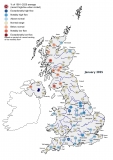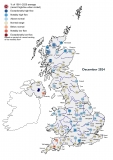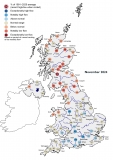British and International Standards are followed as far as possible in the design, installation and operation of gauging stations. Most of these Standards include a section devoted to accuracy and many include recommendations for reducing uncertainties in discharge measurements and for estimating the extent of the uncertainties which do arise.
Given the limited depth of most UK rivers, the accuracy of river flows depends primarily on the precision of the stage measurement. Modern sensing and recording instrumentation is capable of measuring water levels to tolerances of a less than a centimetre. However systematic errors can be introduced, for example, by imprecise surveying of the gauging station datum or the growth of algae on the crest of a weir. Figure 1 below, based on over 1000 gauging stations throughout the UK, shows that such errors can have a substantial impact on the derived flows. The change in flow associated with a 10 mm change in stage at the Q95 flow (a standard index of low flow) translates into a flow error of > 20% at around a third of the gauging stations in the UK.
Uncertainties in the stage-discharge relationship can also be substantial, particularly in the extreme flow ranges where relatively few gaugings may be available to define the rating. In gauging sections where the channel's hydraulic characteristics are subject to change (e.g. due to erosion / accretion following a flood, or seasonal variations in the growth of aquatic plants), changes in the stage-discharge relation require careful monitoring to minimise consequential uncertainties in computed flows.
 |
| Figure 1. Sensitivity of UK gauging stations |
The utility or ‘fitness-for-purpose’ of river flow data reflects its accuracy but is also strongly influenced by a number of other factors. Even a small proportion of missing data can greatly reduce the ability to derive meaningful summary statistics (e.g. annual runoff totals or 7-day minima). The nature of hydrometric measurement determines that missing data tends to cluster disproportionately in the extreme flow ranges. This reflects the difficulty of capturing the highest and lowest flows with precision but the exceptional utility of extreme flows underlines the need for both effective data validation procedures and the capability, where appropriate, to derive estimates of missing flows. Judgement needs to be exercised in applying such procedures to avoid archiving misleading flow estimates but, in most circumstances, the inclusion of an auditable and suitably flagged estimate rather than leaving a gap in the record will produce significant benefits in relation to the overall value of the river flow series.



